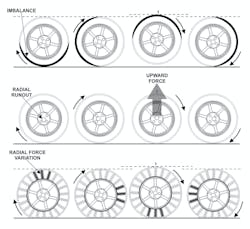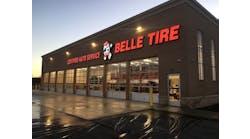In this article, we’ll address a variety of noise, vibration and harshness (NVH) issues. We’ll also offer tips on how to avoid and/or cure these ills.
When trying to solve NVH problems, a good place to start is with the tire and wheel assemblies.
Tire radial force variation
In addition to dynamic balance of a tire/wheel assembly, we need to consider tire radial force variation (RFV) when diagnosing tire-related vibrations that occur at varying speeds and conditions. Ideally, the wheel should be phase matched to align the tire’s point of maximum RFV with the wheel’s point of minimal radial runout (high point of tire to low point of wheel).
Radial force variation is a term that relates to a tire-sourced out-of-round/vibration that occurs, and masks itself as an imbalance vibration, only under dynamic conditions... when the wheel and tire package rolls in a loaded state. It must be noted that the term “radial” refers to forces applied at the radius of the tire, not to the type of tire construction. Radial force vibration could potentially occur with any type of tire, regardless of its construction (radial, bias ply, etc.). In other words, a radial force variation may prove to be the cause of a vibration that won’t reveal itself during a static or dynamic balance job, or by checking the mounted tire for runout in an unloaded state.
Radial force is determined by measuring loaded radial runout. According to Hunter Engineering’s research, on an average passenger car tire/wheel assembly, one thousandth of an inch (0.001 inch) of loaded radial runout is equivalent to approximately one pound of road force.
For example, a measured 0.030 inch of loaded radial runout (about 30 pounds of road force) will cause the same amount of vibration as 1.5 ounces of wheel imbalance at 50 mph, which is five times greater than the .30 ounce imbalance limit.
Tire makers usually supply a red dot on the tire sidewall, which indicates the tire’s maximum RFV, or the highest point of radial runout. When mounting the tire, this red dot should be aligned to a white dot on the wheel (if the wheel is so marked).
The white dot on the wheel indicates the wheel rim’s minimum radial runout point (on a steel wheel, a dimple may be featured that indicates the wheel’s low point).
When using alloy wheels that don’t feature a white dot, the tire’s red dot should be aligned with the valve stem, as this should be the minimum radial runout point.
A yellow dot may be found on the tire sidewall which indicates the lightest point of the tire (in terms of weight from a balance consideration).
If a yellow dot is found, this should be aligned to the wheel’s valve stem, which should be the wheel’s heavy spot in terms of balance. Even if dynamic wheel balance (from a standpoint of weight) is correct, misalignment of the red and white dots will likely result in a vibration complaint. On OE tires and wheels, always align the red tire dot and the white wheel dot (or valve hole, in the case of alloy wheels) when mounting. If the tire features a red dot and a yellow dot, the red dot is more critical and should be aligned with the wheel’s low point (dimple or valve stem).
- Red dot on tire: Align to the wheel’s low-point dimple (steel wheel) or to the valve stem (alloy wheel), or to a white dot on the wheel if the wheel features a white dot.
- Yellow dot on tire: Align to the wheel’s valve stem.
- However, it has been found that aligning the red dot on the tire to the low radial runout point of the wheel doesn’t always correct a potential RFV, although in theory it should. Use of a load force machine is the most accurate method of correcting for RFV.
When a customer complains of a “tire vibration,” although the root cause may simply involve a static imbalance, other factors may be at play, including a static radial runout of the wheel and/or tire, a suspension/chassis problem, or a dynamic-only runout condition, known as radial force variation of the tire.
If static imbalance is the culprit, this is easily cured by balancing the tire/wheel assembly. If runout is the cause, this can be cured by replacing the faulty wheel or tire; or possibly by match-mounting the tire/wheel package. However, when that approach does not fix the problem, the technician must begin a diagnostic approach in order to locate the cause.
Radial runout
When a “mystery” vibration enters the shop, approach the problem in a systematic manner to eliminate possible variables. Naturally, check the tire/wheel assembly for balance on your shop’s balancer. If dynamic balance is verified, begin measuring for excessive runout. First check hub runout in order to identify or eliminate the hub as the possible root cause of the problem.
With the wheel/tire removed from the vehicle, check the runout of the hub. This can be tricky because of clearance at the wheel studs, but can be accomplished with enough patience.
If the wheel is hub-centric (where the wheel relies on hub centering at the wheel hub hole to the hub protrusion), you’ll want to check the runout of the hub itself, at the contact area for the wheel’s center hole. If the hub center protrudes far enough from the wheel studs, mount the dial indicator so that the plunger contacts the hub surface. In some cases, it may be necessary to remove the wheel studs to gain access to the hub contact area. Pre-load the plunger slightly and zero the dial. Rotate the hub slowly, watching for runout on the gauge.
If the wheel is lug-centric (as we mentioned earlier, where the wheel-to-hub centering relies on the location of the wheel fastener holes to the hub’s studs only), you can mount the dial indicator so that the plunger is about .040” away from the outer edge of the wheel stud pattern diameter.
Using a feeler gauge, check for changes in the gap between the dial indicator plunger and the outer edge of the wheel studs as you slowly rotate the hub 360-degrees. Granted, this can be a time-consuming and nit-picky job, but this will either recognize the wheel-to-hub mating as the culprit, or eliminate this variable from your diagnosis. NOTE: Do not use the outer edge of the brake rotor as your measurement point when trying to check hub runout. You must take this measurement at the centering area that the wheel uses, whether this is the hub (for hub-centric wheels) or the wheel studs (for lug-centric wheels).
[PAGEBREAK]
Shimmy
Wheel shimmy (steering wheel right/left oscillation) can be caused by a number of variables. Follow an organized step-by-step inspection:
- Inspect the tires for excessive and uneven wear, and inspect for tire structural damage (badly deformed sidewall, etc.). Poorly constructed tires or damaged tires where plies are misaligned or separating can cause a shimmy/vibration. Check the tire and wheel for proper bead seating along the entire bead circumference on both sides. An improperly seated bead will create a radial runout condition.
- Inspect and adjust tire inflation pressure. Low or uneven pressures on the same axle can cause pulls or wander.
- Check for lateral runout. Using a dial indicator at the wheel rim, slowly rotate the wheel (on the vehicle) a full 360 degrees, noting maximum lateral runout. If excessive lateral runout is found, don’t automatically blame the wheel, since runout may be the result of hub or rotor runout and/or a stack-up of tolerances between the hub, rotor hat and wheel.
- Before removing the wheel/tire assembly, with the suspension unloaded, check for wheel bearing looseness by rocking the tire inward/outward at the 12 and 6-o’clock positions.
- Remove the wheel/tire assembly and inspect the wheel fasteners (studs and nuts or bolts, depending on design). Damaged threads can be an indication of abuse/over-tightening which can contribute to wheel/hub distortion.
- Inspect the mating faces at the rear of the wheel, rotor hat and hub face. A buildup of corrosion can cause a lateral runout condition. Clean all surfaces as needed.
- Check for lateral runout at the hub itself.
- Inspect the wheel rims for damage (bent rims, signs of pothole/impact damage).
- Check/adjust each tire/wheel assembly for dynamic balance.
- Inspect the entire steering and suspension system. Looseness (caused by wear, damage or improper installation) can contribute to a shimmy, in addition to wander and directional pull.
- On the alignment rack, measure all angles, paying particular attention to caster angles. An excessively positive caster (caster angle beyond factory specification for the specific vehicle) can promote a shimmy condition.
- During reinstallation of wheels to the vehicle, always use a torque wrench and follow both the specified torque value and tightening pattern.
Balancing tips
Centering of the wheel, both on the balancer and the vehicle hub is critical. If incorrectly mounted on the balancer, a precision balance won’t be possible.
By the same token, a wheel that is correctly centered (and balanced) on a dynamic balancing machine won’t be able to duplicate the balance (and road force variation variable) if incorrectly centered onto the vehicle hub.
Most wheels are mounted to a balancing machine with a tapered cone that centers the wheel onto the balancer’s shaft. Cones are available with different tapers. Cones that feature a low taper are preferable to better center the wheel. Back-cone mounting is preferred (where the cone mounts from the backside of the wheel).
However, some wheel designs will not center using back-cone mounting. In these cases, front-cone mounting is required, where the cone centers the wheel from the outer side of the wheel.
When using the back-cone method, once the clamping cup and wing nut secures the wheel, depress the foot pedal to hold the spindle in place, and slowly roll the wheel towards you during initial tightening of the wing nut. This helps the wheel to roll up the taper of the cone, instead of trying to force the wheel to slide onto the cone.
When using the front-cone method, pull the top of the wheel/tire away from the hub face while tightening the wing nut. This will help to overcome the force of gravity and improve wheel centering on the machine.
- Verify wheel centering on the vehicle.
- During tire mounting/inflation, if inflation limit is exceeded, deflate, loosen tire bead and re-inflate.
- Match-mount tire to wheel using balance/high spot dots where available.
- Verify the wheel centering on the balancer before beginning spinning.
- Always use two-plane dynamic balancing, even for hidden weights.
- Adjust tire inflation per vehicle specifications.
- Verify wheel centering when final-installed to the vehicle.[PAGEBREAK]
Hub-centric and lug-centric wheels
The terms hub-centric and lug-centric refer to the manner in which the wheels center onto the hubs.
If the wheel relies on centering at the hub, it’s hub-centric.
If the wheel relies on centering by the fastener locations, it’s lug-centric.
If the wheel is not centered onto the hub, radial runout will occur, resulting in a vibration/bounce.
Some aftermarket custom wheels that are designed for hub-centric centering may be made with a large center hole that will accommodate the largest hub in a certain vehicle application.
In order to adapt the wheel (and retain centering), hub-centric rings are required (for example to reduce the hub hole from 88 mm to 72 mm, etc., in order to center onto another vehicle make/model.
If the hub rings are not installed, and the wheel center hole is larger than needed for the hub in question, you can’t necessarily rely on the fastener locations to properly center the wheel on the hub.
Multi-pattern wheels are available in the aftermarket, designed to provide a fitment to more than one bolt circle dimension. While some of these wheels feature multiple bolt holes (for instance, 10 holes where the application is intended for a five-bolt hub), some multi-pattern wheels feature oblong lug holes, designed to accommodate more than one bolt circle.
Instead of the holes being round, they’re oval shaped, allowing mating to likely two bolt circle diameters.
In theory these wheels should be hub-centric so that the wheels are properly centered to the hubs.
These wheels are not very common today, but if you encounter them, extra attention to wheel centering is a must.
After mounting to the hubs, check for radial runout (visually at first, then with a dial indicator).
Inexpensive aftermarket wheels may feature slightly oversized bolt holes and oversized center holes, which can easily create a radial runout condition, resulting in a “thumping” vibration.
Check hub-to-wheel centering to verify that the clearance is even and within the target value of 0.004 inch (0.1 mm) maximum. If the clearance is out of spec, rotate the wheel (wheel clock position relative to the hub).
If the clearance is still out of specification, check the hub for runout to determine if the condition is in the hub or the wheel.
While we’re considering wheel centering, it’s important to note that if the wheel is centered improperly on the balancer, and installed properly centered on the hub, or if properly centered on the balancer but improperly centered on the vehicle hub, a vibrational problem is bound to occur.
If the wheel does not provide a precise “slip fit” onto the hub (being centered by the hub/hub-centric), extra care needs to be taken to center the wheel during installation.
This situation can be common for some budget level aftermarket wheels.
Wheel bearings/hub bearings
Loose, worn or improperly installed front wheel bearings/hub-bearing assemblies can contribute to shimmy/wander, and will make proper wheel alignment impossible.
Always check wheel bearing condition prior to any alignment work, and be sure to measure hub flanges for lateral runout. Note that some bargain-basement-priced hub assemblies may feature short-lived bearings and may feature excessive lateral runout.
High-quality, precision-made hub assemblies produced by reputable makers offer higher quality bearings and tighter runout tolerances to avoid NVH issues. ■
Shake, flutter and shimmy: Inspect all 4 tires and wheels first
Body shake, steering flutter and steering shimmy complaints all involve pinpoint diagnosis of the same components. The condition of the component is what determines which of the symptoms occur. The wheels and tires offer a good starting point, especially if the NVH Analyzer identifies this area as the generating force of the vibration.
Tire and wheel inspection includes checking all four tires regarding manufacturer, size and specifications. Proper tire pressure is also an important item to confirm. Look for damage, deformation and wear. The technician should also rotate the tire and wheel assembly, inspecting both the sidewall and tread to look for obvious conditions caused by road damage, flat spots or runout. It’s also vital to inspect and feel the tread for unusual wear patterns.
Check the tire and wheel for proper bead seating along the entire bead circumference on both sides. An improperly seated bead will create a radial runout condition.
Check hub-to-wheel centering to verify that the clearance is even and within the target value of 0.004 in. (0.1 mm) maximum. If the clearance is out of spec, rotate the wheel (wheel clock position relative to the hub). If the clearance is still out of specification, check the hub for runout to determine if the condition is in the hub or the wheel.




